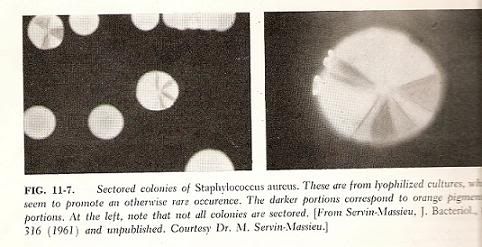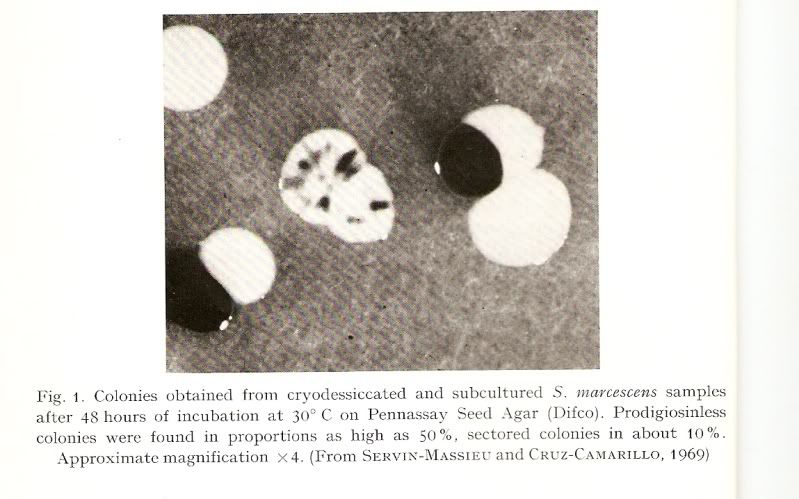MUTATION BY FREEZE DRYING AND...
other aspects regarding potential life evolution in Mars, similar
frozen planets and certain regions of our own earth.
Freeze-drying (lyophilization or cryodessication) is a widely used
preservation technique employed in biotechnology and related
pharmaceutical, medical and biological sciences. It is based in the
freezing of viable or perishable materials and subsequent “sublimation” of the ice formed ( meaning: vacuum elimination of water directly from the frozen to the vapor state without passing through liquid state). With the recent fascinating findings of the late Stanley Miller regarding the formation of “life molecules” under prolonged frozen state conditions (1) and the independent confirmed analyses of periodic freezing-unfreezing cycles of water by sublimation in some regions of the “Red Planet” or Mars surface( 2 ) it is not anymore an outstretched hypothesis to theorize that well sustained mutational effects by freeze-drying in bacteria, found by this author in the laboratory ( 3 ) ( 4 ) ( 5 ), could also be present in our nearest planet, when and only, “life molecules” and/or microbial or microbial like cells be identified; additionally, remember please, that DNA structure is directly dependent on its hydration - dehydration condition. Some implications of this have been discussed in the may 09 2008 text of this blog.
Be that as it may, past “Ice Age” conditions and mountain high freeze-drying mimicking environments, present on our aqueous “Blue marble” planet, could also induce equivalent mutational effects on “earthly” cells, thus representing a hitherto bypassed factor of increased biodiversity at cell or tissue level, not currently considered in studies of species evolution.


Bacterial multiplication on the surface of solid growth media produces "centrifugal" growth of cell population "colony", characteristic of homogeneous species until mutants or "revertants" appear in the apex of the sectors. In "figure 11-7" dark hues correspond to orange colored sectors of Staphycoccus aureus which normally produce carotenoid pigments. In "figure 1" the dark sectors correspond to the blood red pigment characteristic of Serratia marcescens "prodigiosin" producers. Figures taken from references 3.- and 5.-
1.- Fox, D., Did Life Evolve in Ice ? Discover on line, feb 1, 2008
2.- Encrenaz, T., et al,, A mapping of water sublimation…, Astronomy &
Astrophysics,.441,3, oct 2005/ The Smithsonian/NASA Astrophysics data System.
3.- Umbreit, W.W., Modern Microbiology, p.204, ed. W. H. Freeman & Co, Sn. Fco.&
London, 1962
4.- Servin-Massieu, M., and R. Cruz –Camarillo, Variants of Serratia marcescens induced
by freeze-drying, Appl. Microbiol., vol.18, 689,1969
5.- Servin-Massieu, M., Effects of Freeze-Drying & Sporulation on Microbial Variation, Curr. Top. Microbiol. Immunol., 54,119,1971
frozen planets and certain regions of our own earth.
Freeze-drying (lyophilization or cryodessication) is a widely used
preservation technique employed in biotechnology and related
pharmaceutical, medical and biological sciences. It is based in the
freezing of viable or perishable materials and subsequent “sublimation” of the ice formed ( meaning: vacuum elimination of water directly from the frozen to the vapor state without passing through liquid state). With the recent fascinating findings of the late Stanley Miller regarding the formation of “life molecules” under prolonged frozen state conditions (1) and the independent confirmed analyses of periodic freezing-unfreezing cycles of water by sublimation in some regions of the “Red Planet” or Mars surface( 2 ) it is not anymore an outstretched hypothesis to theorize that well sustained mutational effects by freeze-drying in bacteria, found by this author in the laboratory ( 3 ) ( 4 ) ( 5 ), could also be present in our nearest planet, when and only, “life molecules” and/or microbial or microbial like cells be identified; additionally, remember please, that DNA structure is directly dependent on its hydration - dehydration condition. Some implications of this have been discussed in the may 09 2008 text of this blog.
Be that as it may, past “Ice Age” conditions and mountain high freeze-drying mimicking environments, present on our aqueous “Blue marble” planet, could also induce equivalent mutational effects on “earthly” cells, thus representing a hitherto bypassed factor of increased biodiversity at cell or tissue level, not currently considered in studies of species evolution.


Bacterial multiplication on the surface of solid growth media produces "centrifugal" growth of cell population "colony", characteristic of homogeneous species until mutants or "revertants" appear in the apex of the sectors. In "figure 11-7" dark hues correspond to orange colored sectors of Staphycoccus aureus which normally produce carotenoid pigments. In "figure 1" the dark sectors correspond to the blood red pigment characteristic of Serratia marcescens "prodigiosin" producers. Figures taken from references 3.- and 5.-
1.- Fox, D., Did Life Evolve in Ice ? Discover on line, feb 1, 2008
2.- Encrenaz, T., et al,, A mapping of water sublimation…, Astronomy &
Astrophysics,.441,3, oct 2005/ The Smithsonian/NASA Astrophysics data System.
3.- Umbreit, W.W., Modern Microbiology, p.204, ed. W. H. Freeman & Co, Sn. Fco.&
London, 1962
4.- Servin-Massieu, M., and R. Cruz –Camarillo, Variants of Serratia marcescens induced
by freeze-drying, Appl. Microbiol., vol.18, 689,1969
5.- Servin-Massieu, M., Effects of Freeze-Drying & Sporulation on Microbial Variation, Curr. Top. Microbiol. Immunol., 54,119,1971

2 Comments:
Hola Dr. Servin:
Lo he buscado pero tenía antes un correo con AOL (carambolas), así que lo busco ahora por esta via para recomendarle mi blog
mexicanvirus\blogspot.com
By Otroforominero, at 8:36 PM
Otroforominero, at 8:36 PM
Por acá sigo "pataleando" gracias a la maravilla de internet y la eficiencia/eficacia de "Google"...
¡Cuanta información circula! al respecto del problema que me ocupa en esta nota y que es una paradoja aún casi desconocida por muchos biólogos: VIDA Y SU BIODIVERSIDAD, PARECEN TENER SU ORIGEN EN...¡EL HIELO Y LA DESECACIÓN!
Saludos MSM
By Manuel Servín Massieu (Coyote), at 2:49 PM
Manuel Servín Massieu (Coyote), at 2:49 PM
Post a Comment
<< Home